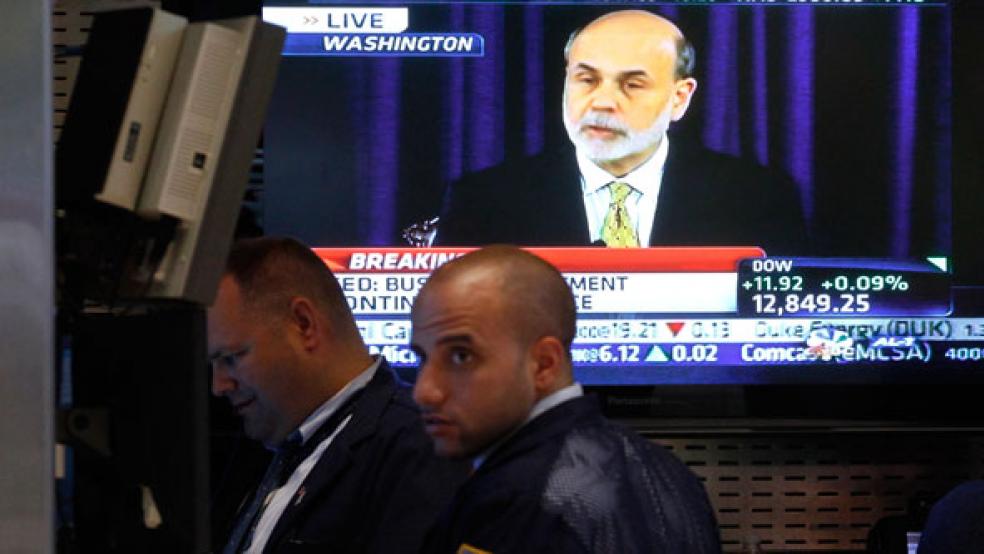Investors have been on tenterhooks for months to see just when and how the Federal Reserve would start to pull back on its $85 billion in monthly bond purchases intended to stimulate asset prices and economic activity. They expect an answer today.
By late this afternoon, we’ll know whether the Federal Reserve Open Market Committee is going to ease up on that quantitative easing program and whether it will go for a “hard taper” – seemingly unlikely – or opt for “soft taper” that more gradually winds down the bond buying. Will the current $85 billion in monthly purchases of fixed income securities be cut to $75 billion? $70 billion? Or might the reduction be more dramatic?
As anxious as investors have been, the market hasn’t suffered much through the wait. The Dow Jones Industrial Average is up 11 of the last 14 trading days, and ended Tuesday less than a percentage point away from its all-time high. Still, the outcome of the Fed’s two-day meeting is not only uncertain, but significant: A lot rides on getting it right.
The U.S. economy, based on recent data, is still struggling with lackluster growth. The Census Bureau reported yesterday that U.S. household incomes have stopped falling, appearing to flatten out at a median of $51,017 last year. The trend may be encouraging, but not the figure, which is well below the $55,627 level recorded in 2007, before the financial crisis wreaked havoc on the economy and investors’ portfolios. Similarly, while unemployment levels are declining slowly, almost grudgingly, much of the improvement has been due to workers leaving the labor force. Economic growth, as measured by GDP, is ho-hum, and retail sales are starting to flag.
RELATED: BUDGET BRAWL COULD SIDESWIPE FED PLANS TO TAPER
The recent spike in long-term interest rates, caused by Fed Chairman Ben Bernanke’s public discussion of the looming taper beginning in late May, has caused an uptick in mortgage rates, too. That may already be taking a toll on one of the few bright spots in the economy – housing – and could eventually dent demand for other major purchases that must be financed, such as cars.
On the other hand, the economy is doing well enough to cope with some kind of taper – and the Fed can’t keep propping up the economy ad infinitum. Clearly, Bernanke had been hoping that, by now, the economy would be humming along at a slightly faster pace, making it possible to simply beginning cutting back on the quantitative easing program and heave a sigh of relief that nothing too bad was likely to happen in response. The fact that the data hasn’t cooperated makes the Fed’s decision more risky, and the distinction between a “hard taper” and “soft taper” more important. Get it right, and the markets will accept the decision and the economy will adjust. Get it wrong, and both could head into a tailspin.
The perception that the likely nominee to replace Bernanke as Fed chair is now Janet Yellen rather than the slightly more hawkish Larry Summers may make it easier for the Fed to opt for a “soft taper” at this point, which also would be seen as appropriate in light of the still-mixed data.
On the other hand, opting for too soft an approach also would be an error. The Fed has conditioned investors in both the fixed income and equity markets to expect a reduction in the monthly bond-buying program. Failing to follow through might send out the wrong signals: that policymakers are divided; that they are seeing something deeply worrying in the data that the rest of us have missed.
Whatever the reason for a failure to act, the result would be that any future attempts by Fed policymakers to guide markets would be viewed with greater skepticism. It also would be a decision subject to a lot of second-guessing: To the extent that this round of quantitative easing hasn’t really had a dramatic effect on the economy or employment, what is the logic in extending the program, just in case something suddenly changes?
On the flip side, being more aggressive, and cutting back bond purchases to $65 billion a month or less, would also be a high risk proposition in light of the recent economic data. The Fed likes to act in response to trends that are establishing themselves, rather than in anticipation of them, and this time it doesn’t have that luxury.
This time, instead of steering a course between a hard landing and a soft landing, the Fed’s policy gurus need to find the right taper strategy – not too hard and not too soft. This is uncharted territory, and it’s little wonder that across the markets, investors and traders are holding their collective breath.







